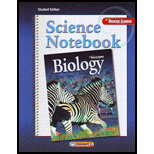
To fill:
Correct words from the given list to complete the given paragraph.
Introduction:
Cells reproduce by a cycle of growing and dividing called the cell cycle. There are three main stages of a cell cycle; interphase, mitosis and cytokinesis. A cell cycle has built in checkpoints that monitor the cycle and can stop the cycle if something goes wrong. There are three checkpoints; G1, G2 and M to control the speed at which a cell moves through a cell cycle.
Answer to Problem 4MI
Cells use cyclins and cyclin- dependent kinases to control the cell cycle. Different combinations of cyclin/ CDK start the cycle at different checkpoints. The cell also uses cyclin/ CDK to monitor the cycle for quality control. In G1stage, the cell checks the DNA for damage. If there is any damage, the cycle won’t proceed to S stage. In mitosis, if the spindle apparatus is malfunctioning, the cycle won’t proceed to cytokinesis.
Explanation of Solution
Cell cycle is controlled by a mechanism involving certain proteins and enzymes. Proteins called cyclins bind to enzymes called cyclin- dependent kinases (CDK) during the stages of interphase and mitosis to signal the cell to start the process of cell cycle. Different cyclin and CDK combinations control different activities at different stages of cell cycle. They also check the cycle for quality control. There are three checkpoints; G1, G2 and M to control the speed at which a cell moves through a cell cycle.
A cell spends most of the time in interphase. It is the stage in which a cell grows, carries out cellular activities and replicates. It makes copies of DNA to enter the next stage of the cycle. During interphase a cell does not divide but prepares itself for cell division. There are three stages in interphase; G1, S and G2. In G1 stage, cell grows, carries out regular cell functions and prepares for synthesis of DNA. The G1 checkpoint checks for any damage in DNA. If everything is right then only the cell proceeds to next stage. In S stage
The next stage is mitosis in which cell’s nucleus and nuclear material divides. If there is any problem with the spindle apparatus during this stage, the cell would not move to next stage of cytokinesis.
Additional Science Textbook Solutions
Microbiology: An Introduction
Organic Chemistry (8th Edition)
Concepts of Genetics (12th Edition)
Applications and Investigations in Earth Science (9th Edition)
Cosmic Perspective Fundamentals
Human Anatomy & Physiology (2nd Edition)
- What is behavioral adaptarrow_forward22. Which of the following mutant proteins is expected to have a dominant negative effect when over- expressed in normal cells? a. mutant PI3-kinase that lacks the SH2 domain but retains the kinase function b. mutant Grb2 protein that cannot bind to RTK c. mutant RTK that lacks the extracellular domain d. mutant PDK that has the PH domain but lost the kinase function e. all of the abovearrow_forwardWhat is the label ?arrow_forward
- Can you described the image? Can you explain the question as well their answer and how to get to an answer to an problem like this?arrow_forwardglg 112 mid unit assignment Identifying melting processesarrow_forwardGive only the mode of inheritance consistent with all three pedigrees and only two reasons that support this, nothing more, (it shouldn't take too long)arrow_forward
- Oarrow_forwardDescribe the principle of homeostasis.arrow_forwardExplain how the hormones of the glands listed below travel around the body to target organs and tissues : Pituitary gland Hypothalamus Thyroid Parathyroid Adrenal Pineal Pancreas(islets of langerhans) Gonads (testes and ovaries) Placentaarrow_forward
- What are the functions of the hormones produced in the glands listed below: Pituitary gland Hypothalamus Thyroid Parathyroid Adrenal Pineal Pancreas(islets of langerhans) Gonads (testes and ovaries) Placentaarrow_forwardDescribe the hormones produced in the glands listed below: Pituitary gland Hypothalamus Thyroid Parathyroid Adrenal Pineal Pancreas(islets of langerhans) Gonads (testes and ovaries) Placentaarrow_forwardPlease help me calculate drug dosage from the following information: Patient weight: 35 pounds, so 15.9 kilograms (got this by dividing 35 pounds by 2.2 kilograms) Drug dose: 0.05mg/kg Drug concentration: 2mg/mLarrow_forward
 Human Anatomy & Physiology (11th Edition)BiologyISBN:9780134580999Author:Elaine N. Marieb, Katja N. HoehnPublisher:PEARSON
Human Anatomy & Physiology (11th Edition)BiologyISBN:9780134580999Author:Elaine N. Marieb, Katja N. HoehnPublisher:PEARSON Biology 2eBiologyISBN:9781947172517Author:Matthew Douglas, Jung Choi, Mary Ann ClarkPublisher:OpenStax
Biology 2eBiologyISBN:9781947172517Author:Matthew Douglas, Jung Choi, Mary Ann ClarkPublisher:OpenStax Anatomy & PhysiologyBiologyISBN:9781259398629Author:McKinley, Michael P., O'loughlin, Valerie Dean, Bidle, Theresa StouterPublisher:Mcgraw Hill Education,
Anatomy & PhysiologyBiologyISBN:9781259398629Author:McKinley, Michael P., O'loughlin, Valerie Dean, Bidle, Theresa StouterPublisher:Mcgraw Hill Education, Molecular Biology of the Cell (Sixth Edition)BiologyISBN:9780815344322Author:Bruce Alberts, Alexander D. Johnson, Julian Lewis, David Morgan, Martin Raff, Keith Roberts, Peter WalterPublisher:W. W. Norton & Company
Molecular Biology of the Cell (Sixth Edition)BiologyISBN:9780815344322Author:Bruce Alberts, Alexander D. Johnson, Julian Lewis, David Morgan, Martin Raff, Keith Roberts, Peter WalterPublisher:W. W. Norton & Company Laboratory Manual For Human Anatomy & PhysiologyBiologyISBN:9781260159363Author:Martin, Terry R., Prentice-craver, CynthiaPublisher:McGraw-Hill Publishing Co.
Laboratory Manual For Human Anatomy & PhysiologyBiologyISBN:9781260159363Author:Martin, Terry R., Prentice-craver, CynthiaPublisher:McGraw-Hill Publishing Co. Inquiry Into Life (16th Edition)BiologyISBN:9781260231700Author:Sylvia S. Mader, Michael WindelspechtPublisher:McGraw Hill Education
Inquiry Into Life (16th Edition)BiologyISBN:9781260231700Author:Sylvia S. Mader, Michael WindelspechtPublisher:McGraw Hill Education





